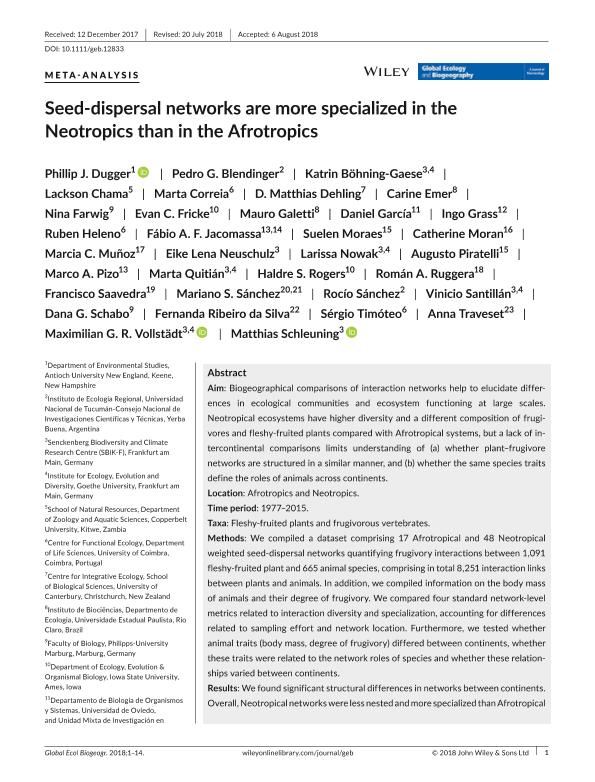Artículo
Seed-dispersal networks are more specialized in the Neotropics than in the Afrotropics
Dugger, Phillip J.; Blendinger, Pedro Gerardo ; Böhning Gaese, Katrin; Chama, Lackson; Correia, Marta; Dehling, D. Matthias; Emer, Carine; Farwig, Nina; Fricke, Evan C.; Galetti, Mauro; García, Daniel; Grass, Ingo; Heleno, Ruben; Jacomassa, Fábio A. F.; Moraes, Suelen; Moran, Catherine; Muñoz, Marcia C.; Neuschulz, Eike Lena; Nowak, Larissa; Piratelli, Augusto; Pizo, Marco A.; Quitián, Marta; Rogers, Haldre S.; Ruggera, Román Alberto
; Böhning Gaese, Katrin; Chama, Lackson; Correia, Marta; Dehling, D. Matthias; Emer, Carine; Farwig, Nina; Fricke, Evan C.; Galetti, Mauro; García, Daniel; Grass, Ingo; Heleno, Ruben; Jacomassa, Fábio A. F.; Moraes, Suelen; Moran, Catherine; Muñoz, Marcia C.; Neuschulz, Eike Lena; Nowak, Larissa; Piratelli, Augusto; Pizo, Marco A.; Quitián, Marta; Rogers, Haldre S.; Ruggera, Román Alberto ; Saavedra, Francisco; Sanchez, Mariano Sebastian
; Saavedra, Francisco; Sanchez, Mariano Sebastian ; Sánchez, Rocío
; Sánchez, Rocío ; Santillán, Vinicio; Schabo, Dana G.; da Silva, Fernanda Ribeiro; Timóteo, Sérgio; Traveset, Anna; Vollstädt, Maximilian G. R.; Schleuning, Matthias
; Santillán, Vinicio; Schabo, Dana G.; da Silva, Fernanda Ribeiro; Timóteo, Sérgio; Traveset, Anna; Vollstädt, Maximilian G. R.; Schleuning, Matthias
 ; Böhning Gaese, Katrin; Chama, Lackson; Correia, Marta; Dehling, D. Matthias; Emer, Carine; Farwig, Nina; Fricke, Evan C.; Galetti, Mauro; García, Daniel; Grass, Ingo; Heleno, Ruben; Jacomassa, Fábio A. F.; Moraes, Suelen; Moran, Catherine; Muñoz, Marcia C.; Neuschulz, Eike Lena; Nowak, Larissa; Piratelli, Augusto; Pizo, Marco A.; Quitián, Marta; Rogers, Haldre S.; Ruggera, Román Alberto
; Böhning Gaese, Katrin; Chama, Lackson; Correia, Marta; Dehling, D. Matthias; Emer, Carine; Farwig, Nina; Fricke, Evan C.; Galetti, Mauro; García, Daniel; Grass, Ingo; Heleno, Ruben; Jacomassa, Fábio A. F.; Moraes, Suelen; Moran, Catherine; Muñoz, Marcia C.; Neuschulz, Eike Lena; Nowak, Larissa; Piratelli, Augusto; Pizo, Marco A.; Quitián, Marta; Rogers, Haldre S.; Ruggera, Román Alberto ; Saavedra, Francisco; Sanchez, Mariano Sebastian
; Saavedra, Francisco; Sanchez, Mariano Sebastian ; Sánchez, Rocío
; Sánchez, Rocío ; Santillán, Vinicio; Schabo, Dana G.; da Silva, Fernanda Ribeiro; Timóteo, Sérgio; Traveset, Anna; Vollstädt, Maximilian G. R.; Schleuning, Matthias
; Santillán, Vinicio; Schabo, Dana G.; da Silva, Fernanda Ribeiro; Timóteo, Sérgio; Traveset, Anna; Vollstädt, Maximilian G. R.; Schleuning, Matthias
Fecha de publicación:
11/2018
Editorial:
Wiley Blackwell Publishing, Inc
Revista:
Global Ecology and Biogeography
ISSN:
1466-822X
Idioma:
Inglés
Tipo de recurso:
Artículo publicado
Clasificación temática:
Resumen
Aim: Biogeographical comparisons of interaction networks help to elucidate differences in ecological communities and ecosystem functioning at large scales. Neotropical ecosystems have higher diversity and a different composition of frugivores and fleshy-fruited plants compared with Afrotropical systems, but a lack of intercontinental comparisons limits understanding of (a) whether plant–frugivore networks are structured in a similar manner, and (b) whether the same species traits define the roles of animals across continents. Location: Afrotropics and Neotropics. Time period: 1977–2015. Taxa: Fleshy-fruited plants and frugivorous vertebrates. Methods: We compiled a dataset comprising 17 Afrotropical and 48 Neotropical weighted seed-dispersal networks quantifying frugivory interactions between 1,091 fleshy-fruited plant and 665 animal species, comprising in total 8,251 interaction links between plants and animals. In addition, we compiled information on the body mass of animals and their degree of frugivory. We compared four standard network-level metrics related to interaction diversity and specialization, accounting for differences related to sampling effort and network location. Furthermore, we tested whether animal traits (body mass, degree of frugivory) differed between continents, whether these traits were related to the network roles of species and whether these relationships varied between continents. Results: We found significant structural differences in networks between continents. Overall, Neotropical networks were less nested and more specialized than Afrotropical networks. At the species level, a higher body mass and degree of frugivory were associated with an increasing diversity of plant partners. Specialization of frugivores increased with the degree of frugivory, but only in the Neotropics. Main conclusions: Our findings show that Afrotropical networks have a greater overlap in plant partners among vertebrate frugivores than the more diverse networks in the Neotropics that are characterized by a greater niche partitioning. Hence, the loss of frugivore species could have stronger impacts on ecosystem functioning in the more specialized Neotropical communities compared with the more generalized Afrotropical communities.
Archivos asociados
Licencia
Identificadores
Colecciones
Articulos(IBS)
Articulos de INSTITUTO DE BIOLOGIA SUBTROPICAL
Articulos de INSTITUTO DE BIOLOGIA SUBTROPICAL
Articulos(IER)
Articulos de INSTITUTO DE ECOLOGIA REGIONAL
Articulos de INSTITUTO DE ECOLOGIA REGIONAL
Articulos(INECOA)
Articulos de INSTITUTO DE ECORREGIONES ANDINAS
Articulos de INSTITUTO DE ECORREGIONES ANDINAS
Citación
Dugger, Phillip J.; Blendinger, Pedro Gerardo; Böhning Gaese, Katrin; Chama, Lackson; Correia, Marta; et al.; Seed-dispersal networks are more specialized in the Neotropics than in the Afrotropics; Wiley Blackwell Publishing, Inc; Global Ecology and Biogeography; 28; 2; 11-2018; 248-261
Compartir
Altmétricas



